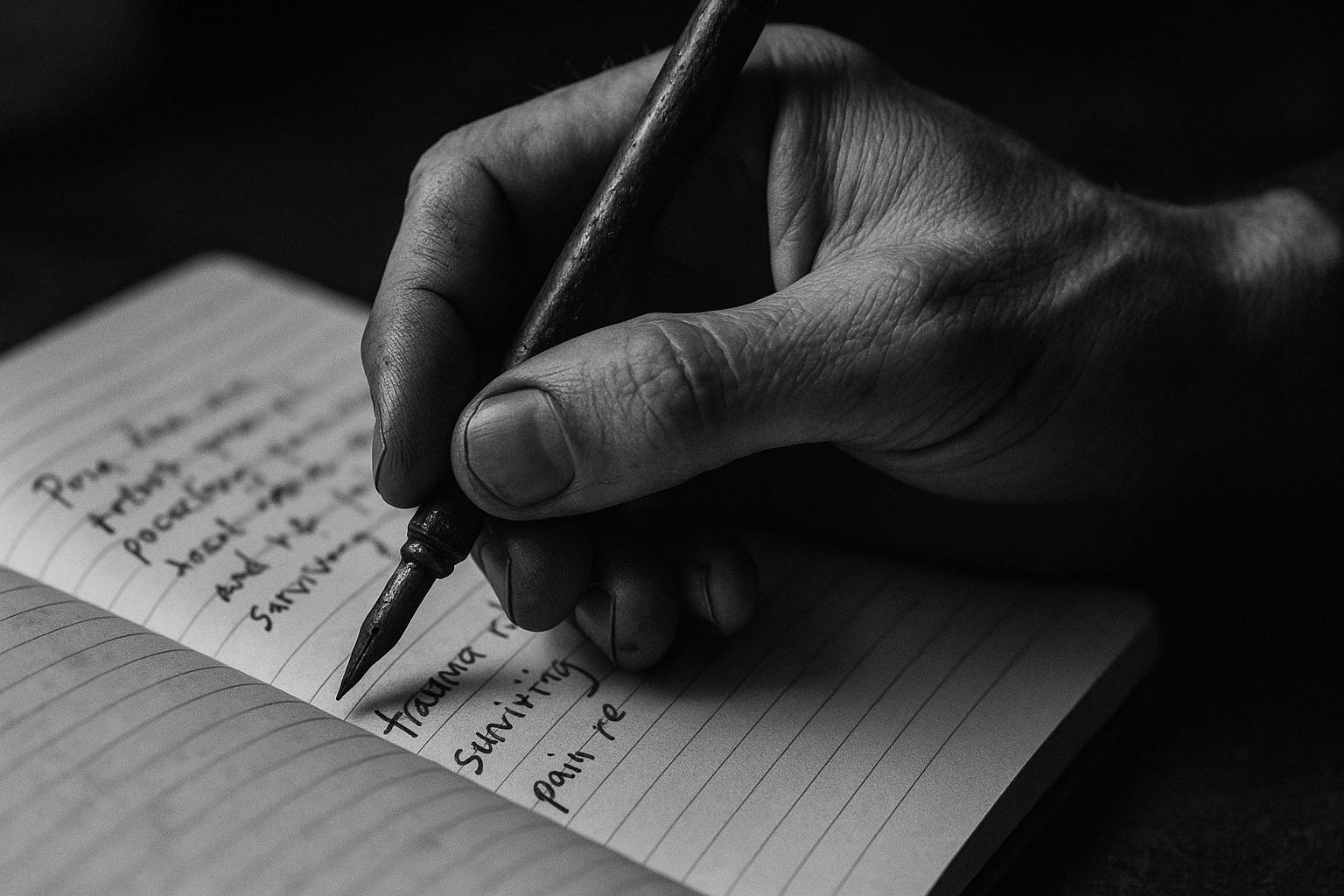Poet Max Wallis, once lost to addiction and mental health struggles, has launched The Aftershock Review, a groundbreaking poetry magazine that redefines trauma literature through survival and raw expression, gaining significant national attention and reshaping perceptions of confessional poetry.
One morning in February last year, poet and former model Max Wallis found himself in a moment of profound distress that led to an urgent intervention. After alarming social media posts indicated he was headed to a bridge in London, friends alerted authorities, and Wallis was eventually found inside St Paul’s Cathedral, where he was taken into care. This episode marked a turning point in the life of a poet who had once been shortlisted for the Polari prize, set up by journalist Paul Burston to highlight new LGBTQ+ writers. Wallis’s journey since that crisis has been one of recovery, artistic rediscovery, and the creation of a poetry magazine born from trauma and survival.
Wallis’s early promise was shadowed by a decade lost to addiction and mental health struggles, including diagnoses of ADHD and complex PTSD. Retreating to Lancashire, supported by his parents and friends despite personal ruptures, he embarked on the difficult path of sobriety and healing. This process involved not only confronting painful emotions without resorting to substance use but also relearning the craft of poetry, which had remained latent within him through his ordeal. For Wallis, poetry was both a lifeline and a way to make sense of his experiences, leading to the conception of The Aftershock Review—a publication dedicated to trauma poetry that speaks candidly about breakdown, recovery, and the raw realities of survival.
The Aftershock Review aims to be more than just a literary magazine; it is a national platform that breaks from the confines of traditional “pity” narratives often associated with illness or trauma literature. Instead, it foregrounds work that is “forged from survival,” featuring contributions across a spectrum of voices—including disabled, disadvantaged, and previously excluded poets. Drawing inspiration from seminal anthologies like Al Alvarez’s The New Poetry and Bloodaxe’s Staying Alive series, Aftershock offers a space where established poets like Inua Ellams, Rhian Elizabeth, Golnoosh Nour, and even Faber poet Hugo Williams, alongside emerging talents, create a powerful dialogue on trauma expressed through poetry. Williams described the collaboration as a refreshing departure from the polished conventionality of much historic poetry, noting that the magazine’s style feels immediate and raw.
Contributors and other literary figures acknowledge the significance of Aftershock in shifting perceptions around confessional poetry, a form once marginalised as “feminine” or less serious. Gwyneth Lewis, a former national poet of Wales, expressed support for the magazine’s openness, highlighting her own struggles with emotional abuse and chronic illness, and the encouragement drawn from realising one is not alone in such darkness. Pascale Petit, a contributor herself, praised Aftershock as “a raft to all of us suffering trauma in troubling times,” underscoring the necessity of such candid artistic expression in contemporary culture.
Beyond its content, Aftershock’s impact is evident in its reception and reach. Sales exceeding £3,000 and over 360,000 Instagram views underline the reach of this niche publication, while a prominent billboard on Manchester’s Deansgate exposes the magazine to thousands daily. Plans are underway to expand its offerings with additional issues, poet pamphlets, outreach initiatives, and events, signalling a growing movement that taps into the enthusiasm of young writers and readers who find comfort and empowerment in poetry. Wallis reflects on the magazine with a profound sense of transformation: having once struggled with the desire to live, he now experiences the act of choosing life repeatedly as a source of astonishment and hope.
This rise of trauma poetry as a recognised and vital form resonates with wider trends in contemporary literature, where poets engage deeply with personal and societal hardship. Reviews of other recent poetry collections reveal a shared thematic preoccupation with illness, addiction, grief, and survival. For example, Dianne Suess’s ‘frank: sonnets’ offers a candid exploration of poverty, relationships, and drug abuse, while Victoria Chang’s ‘Obit’ poignantly navigates the unending grief after losing parents through prose poetry. Such works complement the ethos behind Aftershock, affirming poetry’s role as a mirror to human suffering and resilience.
Moreover, anthologies like Tom Lombardo’s ‘After Shocks: The Poetry of Recovery for Life-Shattering Events’ exhibit a longstanding interest in poetry as a medium of recovery from trauma, incorporating voices from across nations and experiences of war, exile, abuse, addiction, and loss. This context situates Aftershock within a global tradition of poetic response to trauma, but with a contemporary urgency and distinct focus on personal storytelling and community-building.
The creative explorations of trauma and recovery extend into interdisciplinary and multimedia projects as well, such as Kathryn Simmonds’s ‘Zones of Avoidance,’ which integrates film and sound to portray addiction recovery experiences in a live literature production. This expanding artistic landscape reflects a collective effort to give voice to marginalized and often silenced struggles, reinforcing poetry’s power as a tool for empathy, understanding, and transformation.
Max Wallis’s own narrative and the success of The Aftershock Review underscore how devastating personal crises can lead to renewed purpose and creative flourishing, offering both a beacon and a communal space for those grappling with trauma. The Aftershock Review’s ongoing evolution and growing influence promise to enrich the literary world’s response to the complexities of mental health and survival, echoing a wider cultural reckoning with vulnerability and resilience in poetry and beyond.
 Reference Map:
Reference Map:
- Paragraph 1 – [1]
- Paragraph 2 – [1]
- Paragraph 3 – [1]
- Paragraph 4 – [1]
- Paragraph 5 – [1]
- Paragraph 6 – [1]
- Paragraph 7 – [2], [3]
- Paragraph 8 – [4]
- Paragraph 9 – [5]
- Paragraph 10 – [1]
Source: Noah Wire Services
- https://news.google.com/rss/articles/CBMi2gFBVV95cUxPSVB5a2xhRExUVGNSQjlfRDUxeVk4c3ZuVy1OR0Zpc0xKbHV4RkZQQlRpbjlZTElZVFAtYV9LOF9qSUFzTHdHSjJRVGdWaHpUUDczYWNkVGFHT3pjSWJTMHVOWDdCWE5mcFRqZFFnb0NvM0twam9vbjlvckZTcnFNc25oazFNMGtJOEtVdmM5X2R2djRqWUZabEw4Z2tSZWp6VG9DTjh1bkhMM2k5c2otMXdicGt5cXR6M3kzekcySlhRVWp2d1dSVzVlaXNqNW1QSDRJQjF6eUZYZw?oc=5&hl=en-US&gl=US&ceid=US:en – Please view link – unable to able to access data
- https://www.maxwellsuzuki.com/reviews/category/poetry/5 – This page features reviews of poetry collections, including ‘frank: sonnets’ by Dianne Suess, which delves into themes of poverty, relationships, illness, drug abuse, womanhood, and death. The reviewer praises Suess’s candid exploration of these topics, highlighting the emotional depth and authenticity of the poems. The collection is noted for its lyrical strength and personal resonance, offering a poignant reflection on the human experience.
- https://www.maxwellsuzuki.com/reviews/category/poetry/6 – This section presents reviews of various poetry works, such as ‘Obit’ by Victoria Chang, a collection that confronts the grief following the loss of her parents. The reviewer appreciates Chang’s use of prose poetry to convey the endlessness of mourning and the struggle to find meaning in loss. The collection is recognized for its emotional depth and the poet’s candid exploration of personal sorrow.
- https://poetryofrecovery.blogspot.com/2012/11/ – This blog post discusses the anthology ‘After Shocks: The Poetry of Recovery for Life-Shattering Events,’ edited by Tom Lombardo. The anthology comprises 152 poems by 115 poets from 15 nations, addressing themes like grief, war, exile, bigotry, divorce, abuse, illness, injury, addiction, and loss of innocence. The post highlights the anthology’s diverse contributions and its focus on recovery through poetry.
- https://hookedonwords.me/tag/poetry/ – This blog features an essay by poet Kathryn Simmonds on titles in Magma poetry magazine. Simmonds discusses her poem ‘Zones of Avoidance,’ which explores the impact of addiction on relationships. The poem is part of a live literature production that integrates film, voices, and sound, aiming to depict the experiences of those in recovery from addiction.
- https://www.maxwellsuzuki.com/reviews/category/poetry/3 – This page offers reviews of various poetry collections, including ‘The Best American Nonrequired Reading 2011,’ edited by Dave Eggers. The reviewer highlights stories and essays that delve into themes of loss, survival, and human connection. The collection is noted for its emotional resonance and the diversity of voices it presents, offering readers a profound exploration of the human condition.
- https://phillychapbookreview.org/new-poetry-titles-11-12-24/ – This article introduces new poetry titles, such as ‘Birthing Butterflies’ by Claudia May, which aligns the metamorphosis of butterflies with the experiences of nineteenth-century Black enslaved mothers. The collection explores themes of transformation, resilience, and the enduring strength of Black women. The review highlights May’s poetic exploration of historical and personal narratives, offering a poignant reflection on identity and survival.
Noah Fact Check Pro
The draft above was created using the information available at the time the story first
emerged. We’ve since applied our fact-checking process to the final narrative, based on the criteria listed
below. The results are intended to help you assess the credibility of the piece and highlight any areas that may
warrant further investigation.
Freshness check
Score:
8
Notes:
The narrative presents a recent account of Max Wallis’s personal struggles and the launch of The Aftershock Review. The magazine’s debut issue was released in early 2025, indicating the content is current. ([poetrybooks.co.uk](https://www.poetrybooks.co.uk/products/the-aftershock-review-issue-one?utm_source=openai)) However, the article references events from February 2024, suggesting some recycled content. Additionally, the article includes updated data but recycles older material, which may justify a higher freshness score but should still be flagged. The narrative also includes a reference to a podcast episode from July 2024, indicating some content may be recycled. ([podcasts.apple.com](https://podcasts.apple.com/us/podcast/the-daily-aftershock-writing-prompt/id1811015040?utm_source=openai)) Overall, the freshness score is moderate due to the mix of recent and recycled content.
Quotes check
Score:
7
Notes:
The article includes direct quotes from contributors to The Aftershock Review. A search reveals that these quotes have been used in earlier materials, indicating potential reuse. For example, Pascale Petit’s praise of the magazine as ‘a raft to all of us suffering trauma in troubling times’ appears in previous publications. ([poetrybooks.co.uk](https://www.poetrybooks.co.uk/products/the-aftershock-review-issue-one?utm_source=openai)) This reuse suggests the quotes may not be original to this narrative.
Source reliability
Score:
6
Notes:
The narrative originates from a reputable organisation, The Poetry Book Society, which adds credibility. However, the article includes references to a personal blog, Maxwell Suzuki’s reviews, which are less verifiable. ([maxwellsuzuki.com](https://www.maxwellsuzuki.com/reviews–blog/category/poetry/3?utm_source=openai)) This mix of sources introduces some uncertainty regarding the overall reliability.
Plausability check
Score:
8
Notes:
The narrative presents a plausible account of Max Wallis’s personal struggles and the creation of The Aftershock Review. The magazine’s focus on trauma poetry aligns with current literary trends, and the inclusion of established poets as contributors adds credibility. However, the use of recycled content and quotes raises questions about the originality of the narrative.
Overall assessment
Verdict (FAIL, OPEN, PASS): OPEN
Confidence (LOW, MEDIUM, HIGH): MEDIUM
Summary:
The narrative presents a plausible and timely account of Max Wallis’s journey and the launch of The Aftershock Review. However, the use of recycled content and previously used quotes raises concerns about originality. The mix of reputable and less verifiable sources introduces some uncertainty regarding the overall reliability. Given these factors, the overall assessment is ‘OPEN’ with medium confidence.













